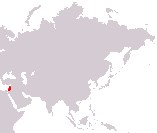
State of Israel
Medinat Yisra'el
Medinat Yisra'el
Government type Parliamentary republic
Area 22,072 kmē (8,522 sq mi)
Population 9,892,000 inh. (2024 est.)
Population density 448 inh/kmē (1,161 inh/miē)
Area 22,072 kmē (8,522 sq mi)
Population 9,892,000 inh. (2024 est.)
Population density 448 inh/kmē (1,161 inh/miē)
Capital Jerusalem (990,000 pop., 1,847,000 urban aggl.)
Currency Israeli new shekel
Human development index 0.919 (22nd place)
Languages Hebrew (official), Arabic
Life expectancy M 81 years, F 85 years
Currency Israeli new shekel
Human development index 0.919 (22nd place)
Languages Hebrew (official), Arabic
Life expectancy M 81 years, F 85 years
Note
The surface area includes the occupied territories of the Golan Heights and East Jerusalem.
GEOGRAPHY DATA OF ISRAEL
Largest cities
Jerusalem 990,000 pop., 1,847,000 urban aggl.
Tel Aviv-Jaffa 479,000 pop., 3,006,000 urban aggl.
Haifa 295,000 pop., 612,000 urban aggl.
Rishon LeZiyyon 263,000 pop.
Petah Tiqwa 257,000 pop.
Netanya 237,000 pop.
Ashdod 228,000 pop.
Bene Beraq 221,000 pop.
Be'er Sheva 215,000 pop.
Highest mountains
Mount Hermon (in Golan Heights) 2,224 m (7,297 ft)
Mount Meron 1,208 m (3,963 ft)
Longest rivers
Jordan River 250 km (155 mi), including parts in Syria, Jordan and Palestine
Largest lakes
Dead Sea 600 kmē (232 sq mi) total, with sections in Jordan and Palestine
Sea of Galilee 164 kmē (63 sq mi)
ADMINISTRATIVE DIVISIONS OF ISRAEL
Israel is divided into 6 districts, with the southern one making up just under 2/3 of the territory; the central district, located between the capital and Tel Aviv, is the most populated and only one over 2 million inhabitants, with all the others in any case over one million people.Apart from Jerusalem, which approaches one million people, all other cities remain under half a million inhabitants; the area between the capital and Tel Aviv has a large concentration of inhabited centers, while the northern area and especially the southern more desert area are less densely populated.

